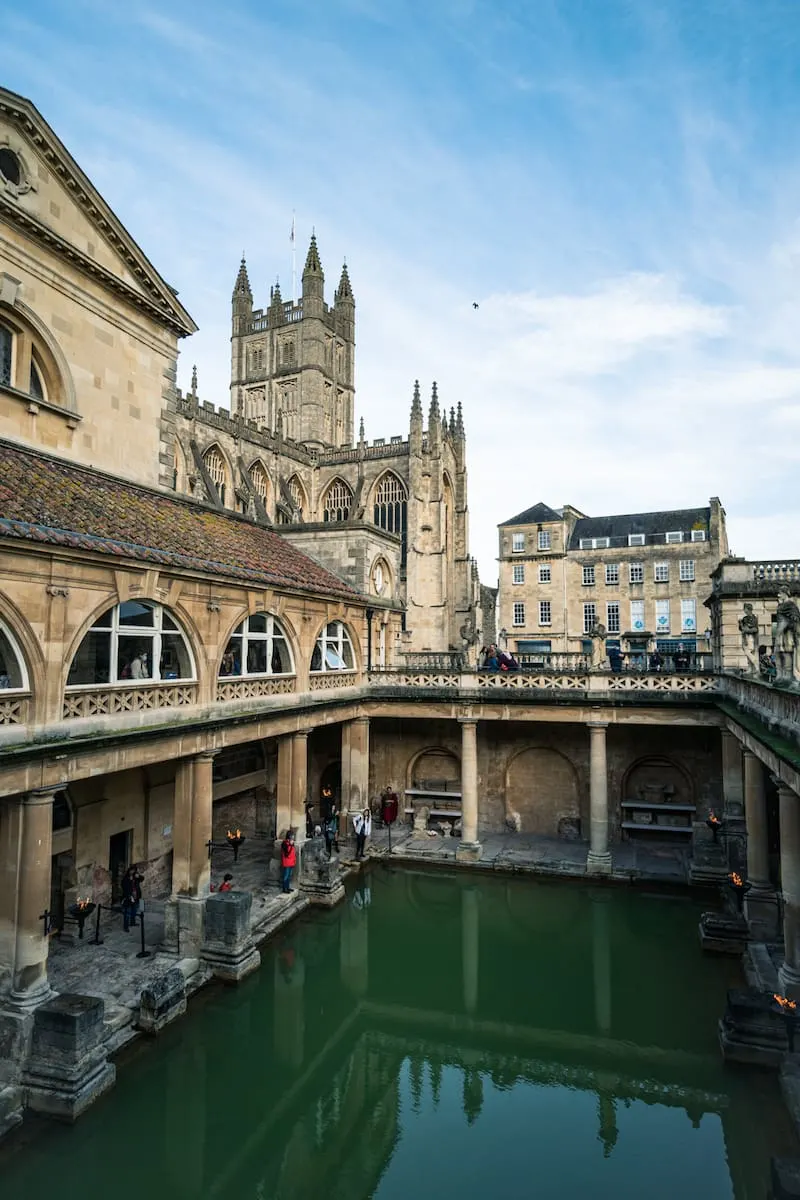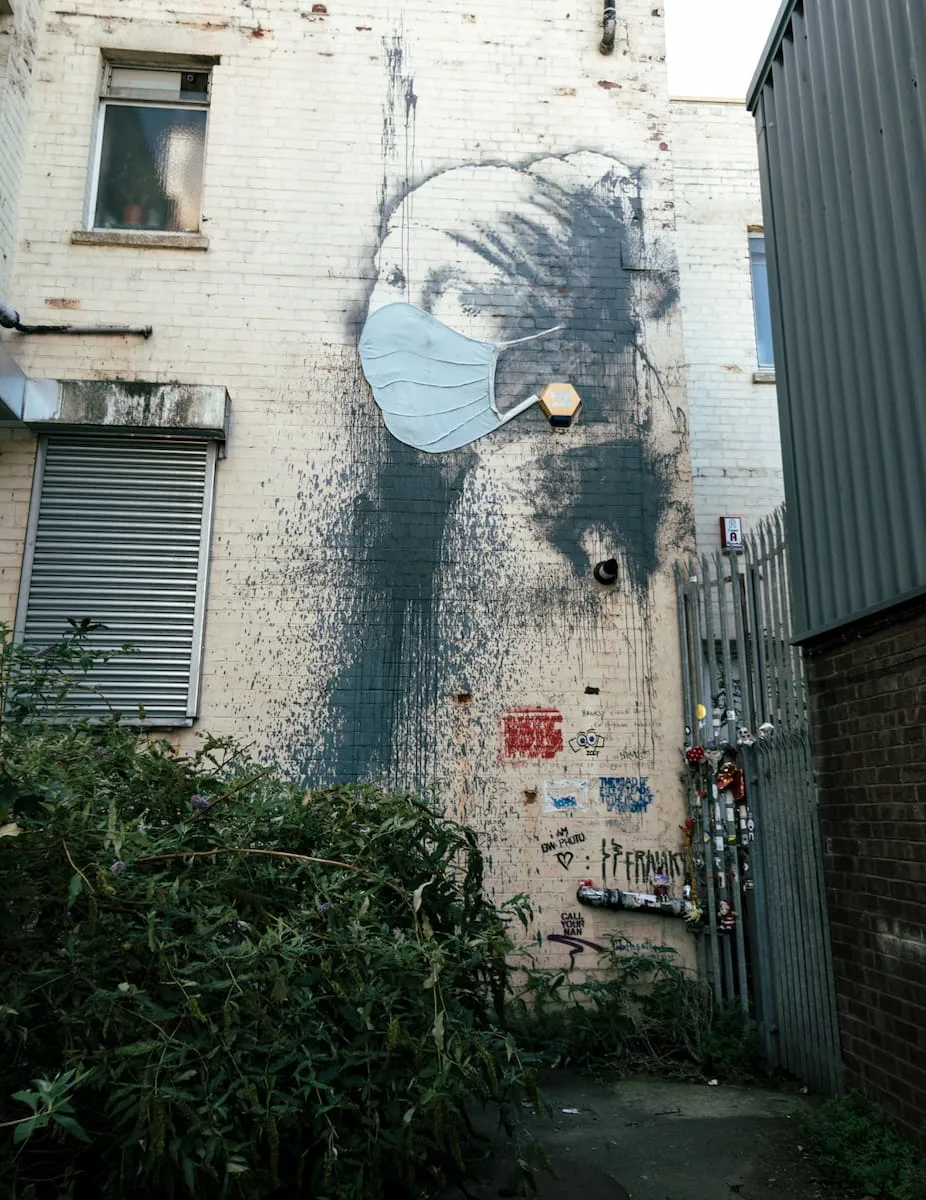Only 12 miles separate Bath and Bristol, but you wouldn’t know that by looking at them.
Despite being only a stone’s throw from one another, these two cities have incredibly different atmospheres. Bath is famous for classical architecture and its historic Roman Baths; Bristol, with its trendy creative scene, is vibrant and exciting.
Both of these cities are popular destinations – and they typically attract two very different types of people. To help you decide whether you should visit Bath or Bristol – or both – I’ve compiled a nifty guide comparing the two.
Disclaimer: Hi! this post may contain affiliate links which will take you to online retailers that sell products and services. If you click on one and buy something, I may earn a commission, see my Affiliate Disclosure for more details.
Reasons to Visit Bath

With 6.25 million tourists visiting every year on average, Bath doesn’t struggle to provide people with reasons to visit.
The city is the epitome of elegance and refinement – when you step out onto paved streets lined with pristine Georgian architecture, you are given the impression that you have not only stepped into a new city, but into a different time.
It’s a fantastic place to explore on foot – everything is conveniently contained within a small area, so it’s a very walkable city.
Here are just a few of the reasons why Bath is so popular.
Beautiful Architecture

Bath is a city made for leisurely strolls.
Gorgeous columns of golden stone and Neo-classical designs of palatial style buildings are the backbone of an astonishingly homogenous city. Turn any corner and you’re simply faced with another beautiful street – all honey-yellow hues of Georgian architecture and Regency elegance.
It’s easily one of the most beautiful cities in England. The entire city is a designated UNESCO World Heritage Site; an honour shared with no other city in the UK.
This is partly due to the Roman Baths, but also the uniform nature of the architecture across Bath. The iconic Bath Stone, a local type of limestone drawn from the quarries of Combe Down and Bathampton Down, gives the city its distinct golden colour.
The Circus and the Royal Crescent are some of the most famous examples of Georgian architecture in the world.
You might recognise parts of Bath from the popular Netflix show Bridgerton. The show takes inspiration from the high society of the Regency era and has many filming locations in the city.
Historic Monuments & Museums

It’s hard to think of a place in England with a historic monument more synonymous with the city than Bath. The Roman Baths are an iconic feature of the city – they’re on the front of every brochure, and do a lot of the heavy lifting for Bath’s tourism sector.
You can visit the luminous green waters of the bathhouse for a slice of ancient history. With the foundations of the Baths built in 70AD, it is one of the best-preserved Roman spas in existence. It’s quite expensive, at £20 per adult, but is unmissable.
- No. 1 Royal Crescent – since you are in all likelihood going to visit the Royal Crescent anyway, you should see inside one of the buildings. No. 1 Royal Crescent has been furnished to look exactly as it would in the late 18th Century. Tickets are £10.60 for adults.
- Fashion Museum – this fashion museum has the unusual honour of being set in Bath’s Assembly Rooms. You get to see fashions from the Regency era and beyond in the setting they would have shined the most. Designer pieces from Dior and the like roundup the more modern examples. Tickets are £9.50 for adults.
- The Jane Austen Centre – experience the world of Mr Darcy as you enter a perfectly preserved example of Regency-era living, detailing the life of Jane Austen. The famous author lived in Bath for several years – her last residence was on the same street as the Centre, and she set both Northanger Abbey and Persuasion in the city. There’s a Jane Austen Festival in Bath every September. Tickets are £12 for adults.
Cute Boutiques & Coffee Shops
As is often the case in quaint historic cities like Bath, there are dozens of independent boutiques and eateries to enjoy. It shares a similar historic-chic vibe with places like Oxford and Cambridge, riding the line between keeping with tradition and introducing exciting modern elements.
You will find many of the usual brands – particularly the pricier ones – in town, but the smaller boutiques are worth a look. Pulteney Bridge is both a picturesque attraction and a shopping destination. The 18th Century bridge is lined with shops, most of which are independent retailers and restaurants.
If you like bookshops, Topping & Company is the kind of bookshop dreams are made of. Think the library from Beauty & the Beast, all tall shelves with ladders to reach the top, but with complimentary tea and coffee.
If you love coffee as much as I do, you have to stop by Colonna & Small’s. It’s an absolute necessity.
The Parks
Wander through the wonderful parks of Bath and get back in touch with nature.
You can head to any of the open green spaces in the city, but the Royal Victoria Park is particularly lovely. The park was opened in 1830 by an 11-year-old Princess Victoria. The 57-acre park is a lovely place to escape for a walk or to relax by the pond.
The Baths
It isn’t called Bath for nothing. The spa capital of England has dozens of wellness centres and spas – thanks to the natural hot springs in the area, it’s been a centre for relaxation for millennia.
The thermal waters that lie beneath the city surface into three springs, and just as the Romans did thousands of years ago, we use the mineral-rich waters to bathe and relax.
You can indulge in the same experience as the Romans at Thermae Bath Spa. The spa is close to the Roman Baths (which you can’t swim in, by the way), using the same spring, but the water is treated, ensuring it is safe to use.
For a luxurious spa experience, try Gainsborough Bath Spa. The spa embraces the Neo-classical architecture of Bath – the thermal waters have very Romanesque surroundings.
Reasons to Visit Bristol
Enter Bath’s grittier cousin: if the cities of South West England are a family, Bristol is the cool one. Bristol is still a laid-back city – they both share a love of cosy coffee shops – but of the two, it is undeniably the ‘fun’ one.
Leaving behind the timeless elegance of Bath for a splash of colour, Bristol has an irrepressible energy that pervades the city.
Off-The-Wall Spirit
Every city has its own feel, and Bristol’s is fiercely independent. Different neighbourhoods have their own unique atmospheres, but the vibrant, creative nature of Bristol can be felt throughout the city.
Head to Stokes Croft, the cultural hub of Bristol, for vintage shops, unusual retailers and street art.
North Street in Bedminster has a similar vibe. It’s slightly more upmarket than Stokes Croft, with bookshops, coffee shops and award-winning restaurants the norm around the street. Upfest Art Festival is hosted on North Street every year in May.
The underground music scene is alive and well in Bristol, and the city is also home to a few popular music festivals in the summer.
Street Art

Keeping in line with that alternative off-the-wall vibe, Bristol is one of the best places in Europe to see world-class street art.
Bristol native Banksy left his mark on the city with a number of famous pieces. You can meander through the city at your own pace or join a guided tour of the city searching for his work.
Much of the street art in Bristol is concentrated in the counter-culture centre of Stokes Croft. The Mild Mild West, boycott Tesco appeal and many other murals can be found in the area. One of Banksy’s most famous works, Well Hung Lover, is located on Frogmore Street.
The Museums

Bristol has some fantastic museums. Even better, many of them are free.
It’s a city with a rich culture and history, and this is reflected in the variety of museums and art galleries dotted around the town.
- The Bristol Museum & Art Gallery – the largest museum in Bristol has a collection that spans millennia, all housed in a magnificent Edwardian Baroque style building. Free entry.
- M Shed – head to the dockyard for a museum all about life in Bristol. The colourful exhibits offer some great insight into the city. Free entry.
- SS Great Britain – board Brunel’s magnificent passenger steamship and explore the first iron steamer to cross the Atlantic Ocean. Tickets are £18 for adults.
- We The Curious – an interactive science museum and planetarium perfect for families. Tickets are around £15 for adults, £10 for kids.
- Arnolfini – overlooking the harbour, this International arts centre embraces the city’s love for contemporary art. Free entry.
Clifton Suspension Bridge

If the Roman Baths are the most recognisable sight in Bath, this is the equivalent for Bristol.
The Clifton Suspension Bridge is an enormous marvel of Victorian engineering – it celebrated its 150th birthday in 2014. Spanning 214 metres – with a total length of 412 metres – and sitting 100 metres above the River Avon, the bridge is as impressive to witness now as it was back then.
You can embark on an hour-long circular walk from Clifton for the best views of the bridge. The walk takes you both under and over the bridge, and through Leigh Woods.
Nightlife
A night out in Bristol is a lot of fun. There’s a bit of everything – it’s almost a mini London in that way. Unlike London, most of Bristol’s nightlife is within walking distance of one another.
Dive bars and cocktail bars, clubs and pubs, stand-up comedy and karaoke: Bristol has something for everyone. It doesn’t matter if your ideal night is in a jazz club or an underground techno punk venue – Bristol has you covered.
Coffee & Food
Bristol is a real foodie city. Whether you’re looking for Michelin stars or pop-up street food, Bristol covers a wide range of dining styles and cuisines. It is particularly blessed with Caribbean restaurants, thanks to a fantastic community that’s been thriving in the city since the 1960s.
One of the best places to try some street food is St Nick’s Market. It’s come a long way since its opening in 1743! You can find everything from Persian to Japanese food among the quirky stalls of St Nicholas.
Bristol and Bath battle it out for the best coffee in the South West, but I think Bristol just edges it.
Maybe that energy and buzz is just the natural result of all the phenomenal coffee in the area? Full Court Press and Little Victories are two of the finest coffee shops in town – the coffee is always of the highest quality.
Where to Stay Overnight
If you’re torn between spending a night in Bristol or a night in Bath this, again, typically depends on personal preference.
If you’re looking for nightlife, there isn’t much competition: while Bath has some cool bars, Bristol’s eclectic mix of pop-ups, pubs and speakeasies far outstrip them in number.
For a quieter, more genteel experience, Bath is undeniably lovely. Staying overnight in Bath gives you the chance to get up early and wander those famous honey-coloured streets before the crowds arrive.
Affordability
In a perfect world, where you spend the night would simply be the city you prefer. But for people travelling on a budget, expenses are often the deciding factor. Accommodation in Bath is unsurprisingly quite expensive, though still affordable compared to London – if you’re on a tighter budget, you will fare better in Bristol.
Two Birds With One Stone?
It doesn’t have to be Bath or Bristol – you can easily do both. A train journey between them takes around 10 to 20 minutes, depending on the number of stops. With such a short travel time, you really owe it to yourself to squeeze in both!
Stay in the city you prefer – if it suits your budget – and do a day trip to the other.
So, Bristol or Bath?
To roundup – these cities offer completely different experiences, but both are worth visiting.
Bath has more attractions than Bristol. It’s more typically tourist-friendly – the Roman Baths are one of the biggest attractions in South West England. For a traditional English experience loaded with history, Bath is the obvious choice.
But the alternative atmosphere of Bristol has its own charm. If you want to experience a grittier urban environment with a lot of personality, the colourful setting of Bristol would be a better fit.
Their differences complement each other well. What one city lacks, the other has in abundance.
To summarise:
Best of Bath:
- Timeless beauty
- Historic – Regency era architecture
- Sophisticated and elegant
- Relax and rejuvenate in the spas
- Great for a bath
Best of Bristol:
- Trendy and young
- Excellent nightlife
- Incredible choice in free museums
- World-class food and street art

Kat
Hi, I'm Kat, an Australian that moved to London in 2013 to start a new adventure. What a roller-coaster that was! I love helping others move to the UK and people explore the world! I’d be honoured if you’d say, “Thanks!” with a £3 coffee on Ko-fi.

